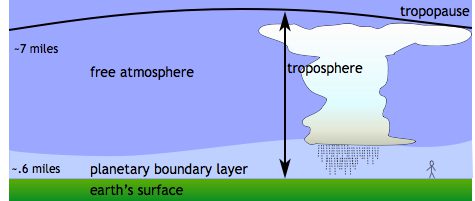

To determine how many viruses fall from the troposphere each day, automatic collectors were placed at two different locations in the Sierra Nevada Mountains of Spain at 1.75 km above sea level. Placing the collectors at this height allows sampling of air above the atmospheric boundary layer (pictured – image credit). Samples were retreived every 1-2 weeks over the course of two years and analyzed for the presence of viruses by flow cytometry after purification by centrifugation.
The results show that billions of viruses fall from the atmosphere each day: from 0.3 to 3.8 x 109 per square meter. Most (69%) of the viruses that descend from the atmosphere are attached to dust or organic aggregates. The rate of falling viruses was not substantially different over the course of the study nor between the two different sites.
Deposition of viruses was 52 times higher than bacteria when air masses originated from the oceans; when they originated from the Saharan desert, the ratio was 28. These data suggest that viruses high in the atmosphere likely originate from aerosols formed at the sea surface.
More viruses are attached to airborne small particles compared with bacteria, leading to a longer ‘hang time’ for viruses. This feature, in turn, should allow viruses to travel very long distances around the Earth, and explain the finding of very similar viruses in distant locations.
The authors call the atmospheric collection of viruses and bacteria a ‘seed bank’ that can provide ecosystems with the ability to adapt to environmental changes. Whether or not the atmospheric viruses are infectious would be interesting to determine. I am also interested in what kinds of viruses are raining from the skies. I’m sure the authors will let us know the answer in a future publication.
As you might expect, this story has been widely covered in the press – the idea that trillions of viruses fall from the skies daily has appeal. However I wonder about the following statement in a NY Times article:
Generally it’s assumed these viruses originate on the planet and are swept upward, but some researchers theorize that viruses actually may originate in the atmosphere. (There is a small group of researchers who believe viruses may even have come here from outer space, an idea known as panspermia.)
Given that viruses absolutely require cells in which to replicate, I am not sure how they would originate from the atmosphere. Are there communities of bacteria and eukaryotes floating above us, hosts to viruses which they drop upon the Earth? If so what would these cells live on? It sounds fanciful and unlikely.
As for viruses coming here from outer space – I doubt it. The intense cosmic radiation, consisting of UV light, X rays, gamma rays, and atomic and subatomic particles, would fry any genome well before it arrived.

Pingback: Viruses are falling from the skies - Virology
Thanks for a lucid and non- sensationalist summary of the paper. Query: Are the viruses bystanders? Do they have an effect on human or animal health? Do they effect weather, ie, cloud seeding? Nathan aka @sciguy999